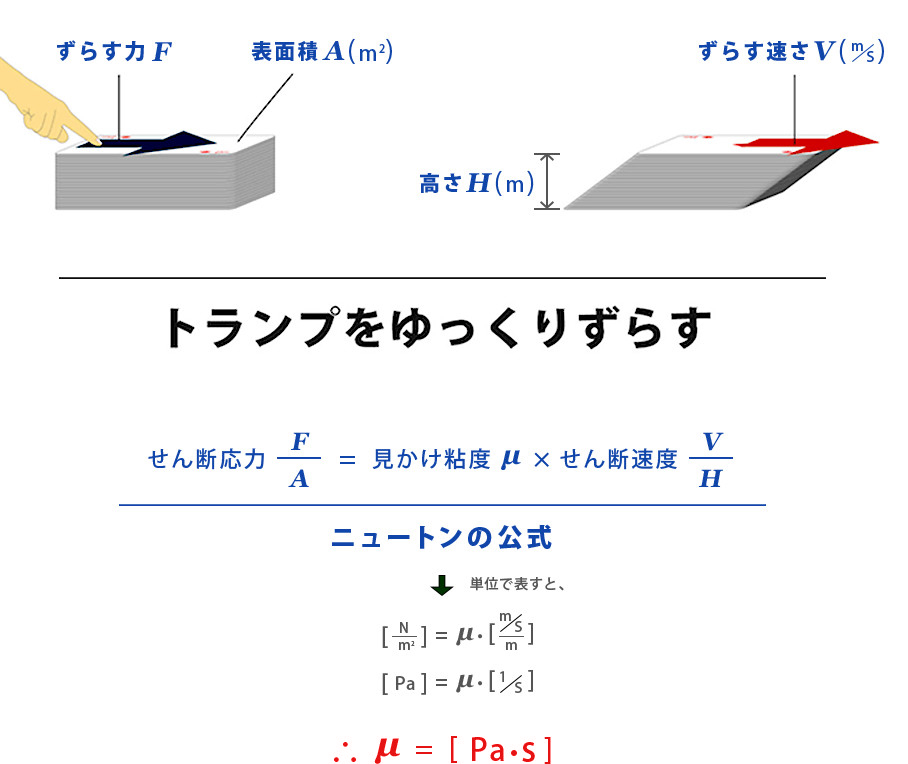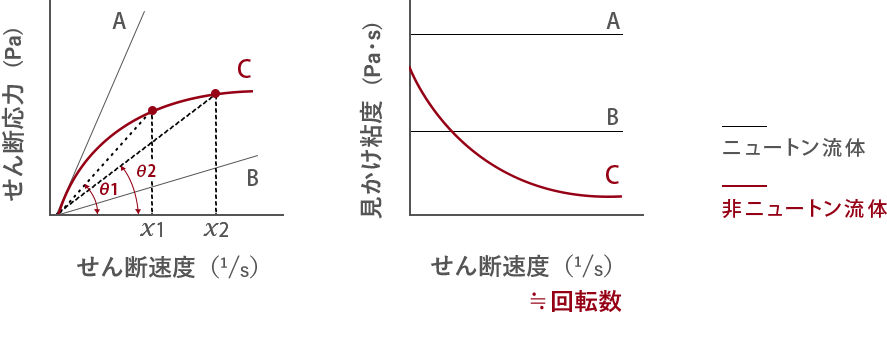 Course 3
Viscosity is the unit of stickiness
Course 3
Viscosity is the unit of stickiness
In the first lecture we said, "Understand the things to be mixed." In this session, we will explain the most important factor for it: viscosity.
Most important factors that describe fluids are density and viscosity. You can determine the density relatively easily as you may consider, "Well, it is a alcohol, so the density should be roughly 750 kg/m3". But viscosity is complicated. Let's consider why it is complicated.
Why does the unit of viscosity include "s" (second)?
The viscosity μ (mu) of water is 1 centipoise (cP) at 20℃. In SI units, 1 cP is 1 millipascal second (mPa・s), and 1000 times that viscosity is 1 pascal second (Pa・s). For example, the viscosity of mayonnaise is said to be 1 to 2 Pa・s. You may think, "Now it is clear! The viscosity is determined by the product of stress (Pa) and time (s)," but a question arises. Why does the unit of viscosity include "s", which indicates the time, even though it just indicates the stickiness of liquids? Don't you think it is strange? The answer to this question is, in short: "Among the fluids handled in the industries such as chemistry, food, cosmetics, and painting, there are many troublesome fluids that change their viscosity largely by changes of their environments.
Non-Newtonian fluid, which resists the teaching of Newton
There are many fluids that largely change their apparent viscosity depending on the environment. The relevant factor of environment is the shear rate (also called as the velocity gradient or rate of shear), and this factor includes time (s).
The Newton formula shown below is illustrated by the figure of the trump below, which describes the model of the shear stress and shear rate of fluid between two panels, which is often mentioned in fluid mechanics. You can see time s (second) is included in the unit description.

This formula shows that viscosity μ is the ratio of the shear stress and the shear rate. With a Newtonian fluid such as water, starch syrup, and silicone, this ratio is constant, i.e. the viscosity does not change even if the shear rate changes.
With Non-Newtonian fluid, on the contrary, this ratio is not constant, i.e. the viscosity changes if the shear rate changes. Typical Non-Newtonian fluids are mayonnaise and margarine.
You need experience and sensitivity to deal with non-Newtonian fluids
There are many types of non-Newtonian fluid if you look into it, but we leave them to specialized books. One thing that we want you to note is the awesome fact: the apparent viscosity largely changes with the shear rate. We want you to note this because the shape and rotation speed of the mixing impeller in a mixing vessel determine the shear rate.
So when you design or use a mixing vessel, you must keep it in mind that the viscosity of the liquid largely changes when the rotation speed changes.
Furthermore, the fluid flow in a mixing vessel has different shear rates at different places in the vessel. This means that the fluid viscosity close to the fast rotating impeller and that near the vessel wall are largely different, and that viscosity varies largely within the vessel. This is the reason that viscosity is troublesome.

Non-Newtonian fluid is changed Apparent Viscosity
But don't worry. There are ways to deal with Non-Newtonian fluids. How well you deal with them is an interesting part of engineering, and it is up to your experience and sensitivity.
Well, so much for this session. In the next session, we will look at how to deal with non-Newtonian fluids in some detail.
-
Mixing Course
Beginner
course -
- Introduction Basic terms of mixing
- Course 1 Basics of basics: Three points to understand mixing
- Course 2 Examples of the purposes of mixing
- Course 3 Viscosity is the unit of stickiness
- Course 4 Consider a mixing vessel as a huge viscometer
- Course 5 Can you see the flow from power change? (Part 1)
- Course 6 Can you see the flow from power change? (Part 2)
- Course 7 Learn the essence of the mixing Reynolds number
- Course 8 Basics of basics of scaling up
- Course 9 Basics of scaling up
- Course 10 What is heat transfer performance in a mixing vessel?
- Course 11 What is film heat transfer coefficient , hi?
- Course 12 Mixing course review
-
Mixing Course
Practical
course -
- Introduction Mixing course SEASON II
- Course 1 Immediately determine the basic specifications of the mixing vessel using three pieces of information: operating liquid volume, viscosity and density.
- Course 2 Find a plan to improve the productivity of the mixing tank on the existing production line! (Part 1)




